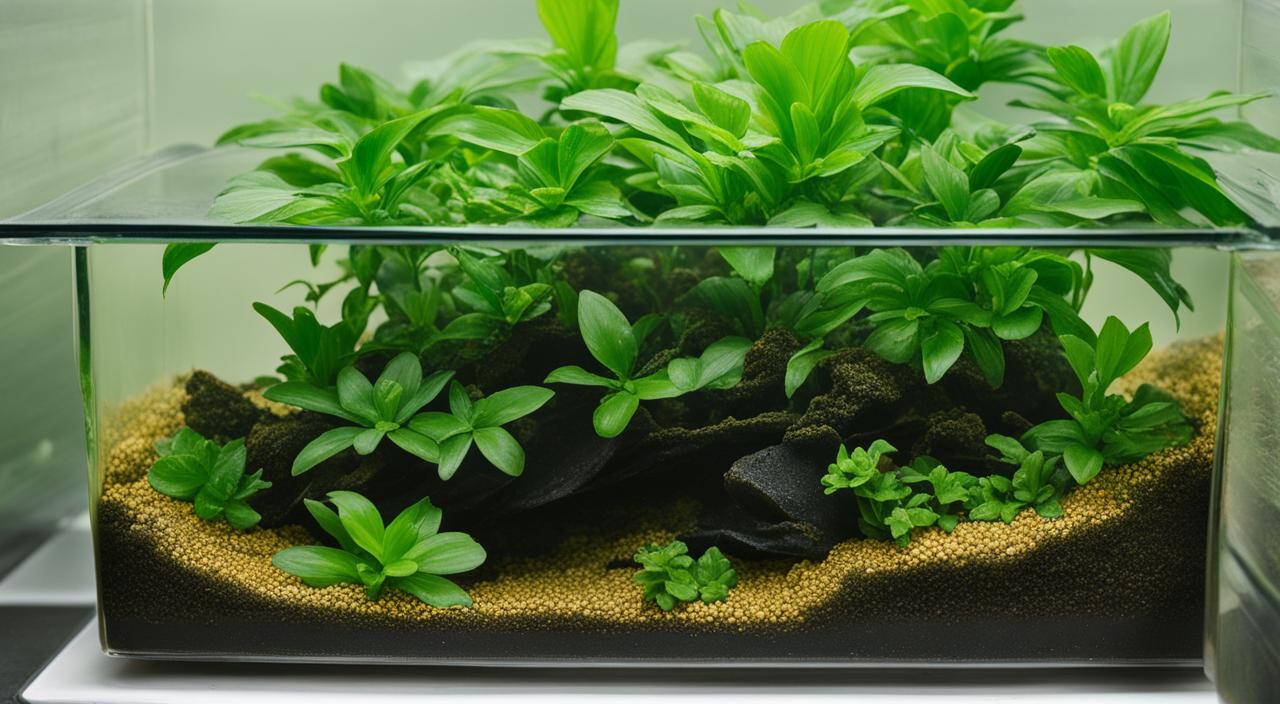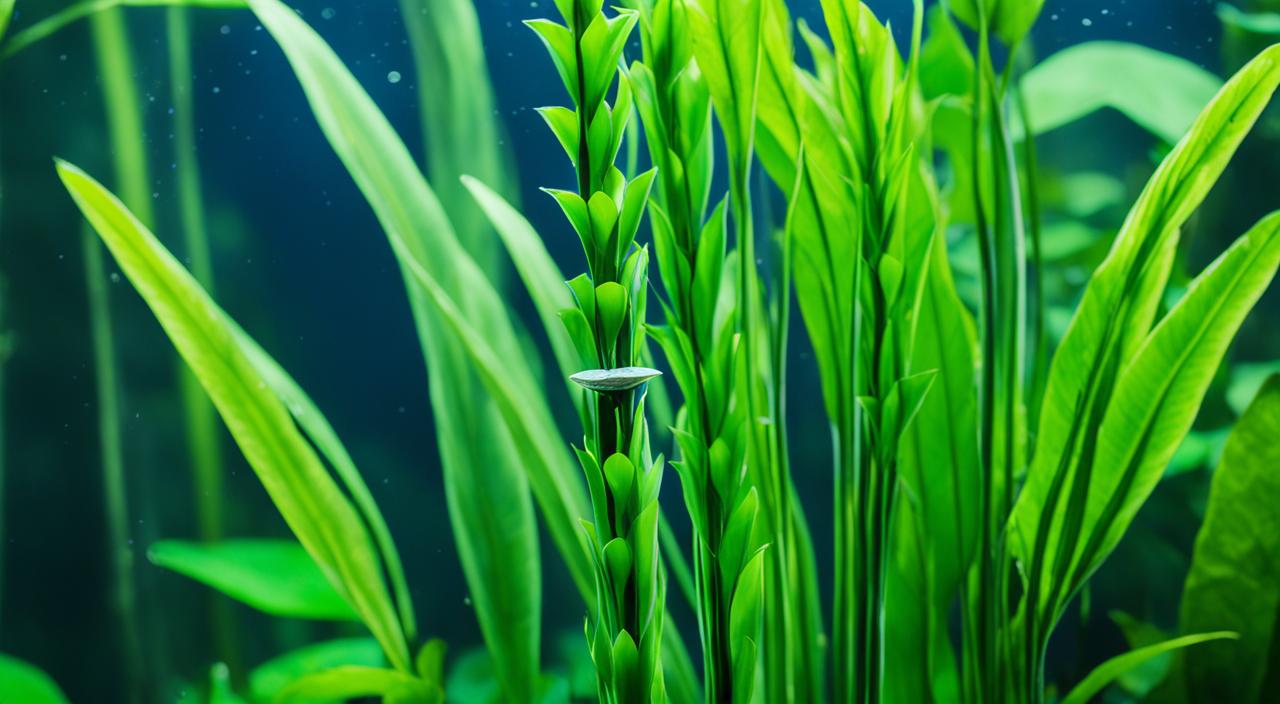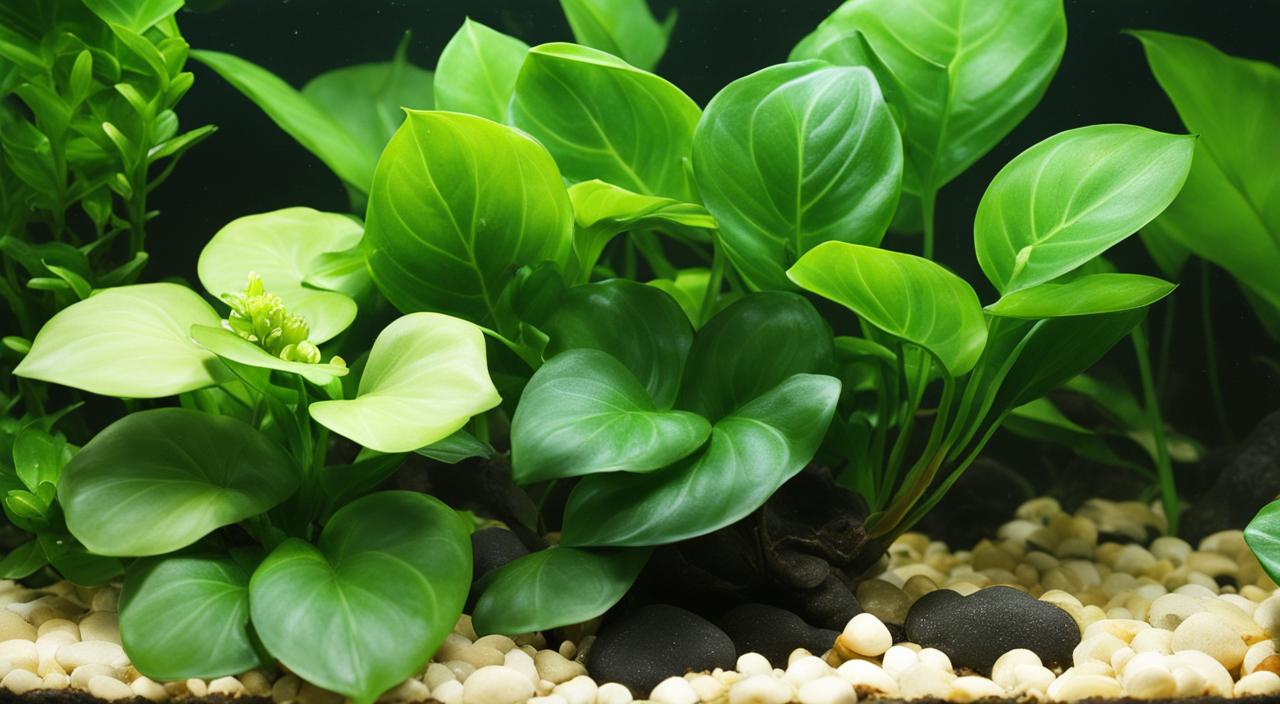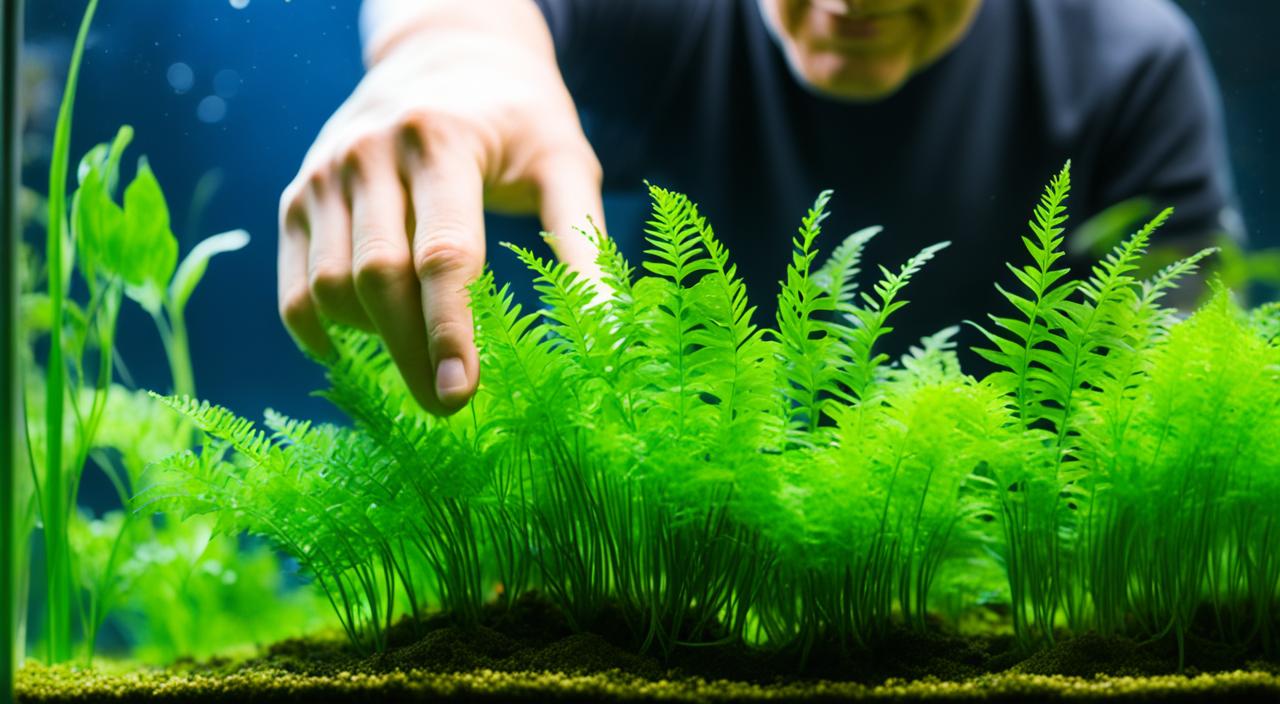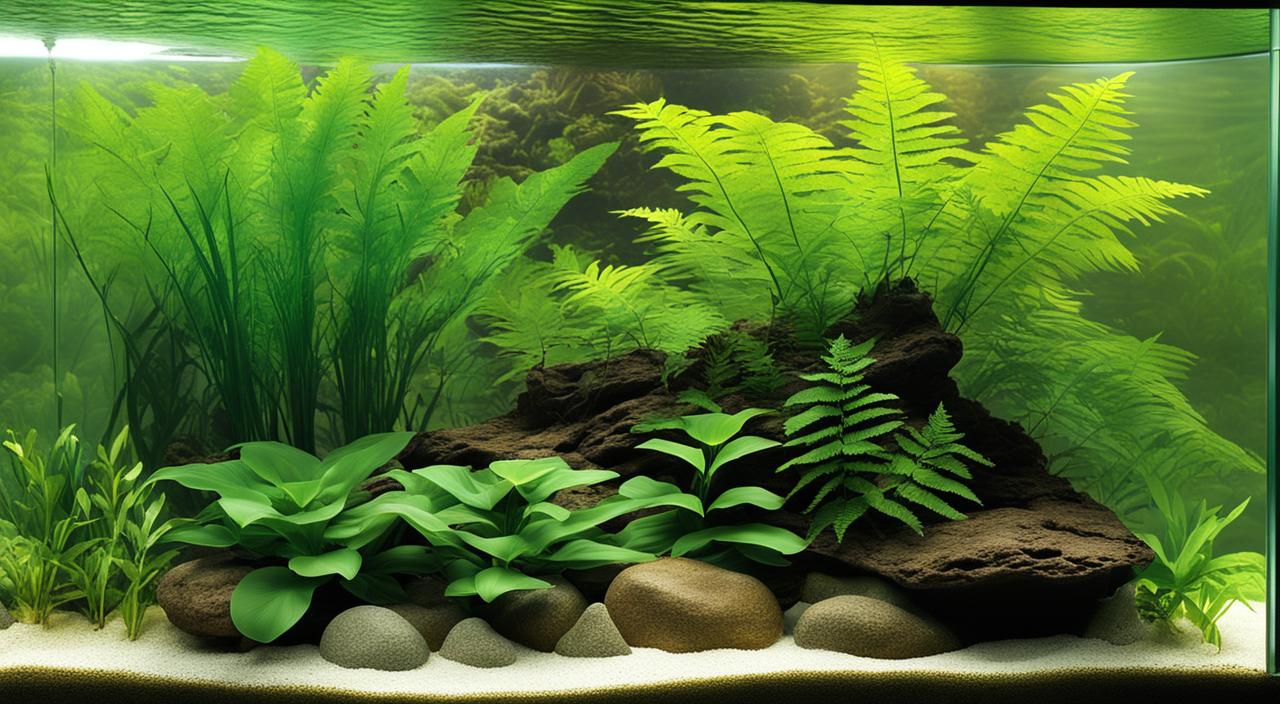Welcome to my bucephalandra care guide, where I will provide you with all the information you need to cultivate and maintain these rare aquatic plants in your freshwater aquascaping project. Bucephalandra, with its unique and attractive foliage, has become increasingly popular among aquarium hobbyists. Whether you are a beginner or an experienced aquarist, this article will be your go-to resource for everything you need to know about bucephalandra.
Regarding exotic aquarium plants, bucephalandra stands out for its captivating beauty and relatively low maintenance requirements. In this guide, I will delve into the origins and habitat of bucephalandra, discuss its morphological characteristics, provide insights on proper placement and lighting, suggest suitable tank mates, and offer tips on fertilization, CO2 injection, and overall care.
Key Takeaways:
- Bucephalandra is a highly sought-after genus of aquatic plants known for its unique and attractive foliage.
- These rare aquatic plants are relatively low maintenance and can significantly add to your freshwater aquascape.
- Bucephalandra comes in various species and varieties, each with its colour and pattern.
- Proper placement and lighting are crucial for the healthy growth of bucephalandra in your aquarium.
- Compatible tank mates include peaceful community fish, shrimp, and snails.
Brief Overview Of Bucephalandra
Bucephalandra, also known as “buce” for short, is a slow-growing aquatic plant that belongs to the genus Bucephalandra. It is native to Borneo and commonly grows along the banks of fast-moving streams. Bucephalandra plants have small, thick leaves and come in various colours and patterns, making them highly desirable among collectors. They are available in multiple species and varieties, including Green Wavy, Kedagang, Red Mini, Blue Mini, Brownie Blue, Theia Green, and Black Pearl. These plants can be purchased as individual plants or as part of collections, and they are commonly found in both farm-raised and tissue culture forms.
Bucephalandra Species Table:
| Characteristic | Bucephalandra |
|---|---|
| Scientific Name: | Bucephalandra spp. |
| Common Names: | Buce, Bucephalandra Green, Bucephalandra Red, etc. (varies by species) |
| Origin: | Borneo, Indonesia |
| Height: | 2-10 cm (varies by species) |
| Growth Rate: | Slow |
| Colour: | Green, red, brown, purple (varies by species and conditions) |
| Aquarium Placement: | Midground to background, attached to rocks or driftwood |
| Water Type: | Freshwater |
| pH: | 6.0 – 7.5 |
| Care Level: | Easy to Moderate |
| Light Requirements: | Low to Medium. LUX: 200-1000, PAR: 50-150 µmol/m²/s, Kelvin: 5000-7000K |
| CO2 Requirements: | Midground to the background, attached to rocks or driftwood |
| Temperature: | 20-28°C (68-82°F) |
| Flow Rate: | Low to Moderate |
| Propagation: | Rhizome division or new shoot separation |
| Feed Type: | Root tabs and liquid fertilizers for micronutrients, especially if not using CO2 injection |
The light requirements for Bucephalandra are generally low to medium. They can thrive under LUX levels of 200-1000, with a PAR range of 50-150 µmol/m²/s. The best Kelvin scale for promoting growth and colour vibrancy in Bucephalandra is between 5000-7000K, simulating natural daylight and effectively supporting photosynthesis.
So, let’s take a closer look at the fascinating world of bucephalandra, its different species and varieties, and the unique characteristics that make it a popular choice among aquarists and aquascapers.
Origins And Habitat
Bucephalandra is a genus of rheophyte plants native to the island of Borneo. These plants are primarily found growing along the banks of fast-moving streams and rivers. In their natural habitat, bucephalandra plants have adapted to thrive in dynamic environments with alternating dry and rainy seasons.
During the dry season, bucephalandra plants grow emersed or above water, adapting to the lower water levels. As the rainy season arrives, these plants transition to a submersed growth form, adapting to the submerged conditions. This unique ability to thrive in emersed and submersed growth forms is a characteristic feature of bucephalandra plants.
Bucephalandra plants display oblong leaves with wavy edges, although certain varieties may exhibit different leaf shapes and textures. The foliage of bucephalandra plants ranges in colour from light to dark greens, and some varieties may even showcase red, purple, or bluish tints. These plants often have small white dots on their leaves and possess an iridescent sheen that varies with the surrounding light.
In their natural habitat, bucephalandra plants may also produce white or pink flowers, adding to their visual appeal.
| Feature | Description |
|---|---|
| Growth Forms | Emersed (above water) and submersed (below water) |
| Leaf Characteristics | Tiny white dots and an iridescent sheen that changes in the light |
| Foliage Colors | Range from light to dark greens; certain varieties may exhibit red, purple, or bluish tints |
| Leaf Markings | Small white dots and an iridescent sheen that changes in the light |
| Flowering | White or pink flowers may be produced |
Morphological Characteristics
Bucephalandra plants exhibit various morphological characteristics that contribute to their unique and attractive appearance. Most varieties of bucephalandra have oblong leaves with wavy edges, creating a visually intriguing texture. However, some types feature different leaf shapes, such as circular leaves, skinnier leaves, or leaves with straight edges.
The foliage colours of bucephalandra range from light to dark greens, adding vibrancy to any aquascape. Certain varieties may even showcase striking tints of red, purple, or bluish hues. Upon close examination, small white dots can be observed on the leaves, creating an intricate pattern that adds to their overall allure.
One of the most captivating features of bucephalandra is the iridescent sheen that adorns their leaves. When exposed to light, this radiance gives the leaves a subtle play of colours, adding depth and dimension to the plant. This combination of leaf shapes, foliage colours, white dots, and iridescent sheen makes bucephalandra a visually stunning addition to any aquarium.
Placement And Lighting
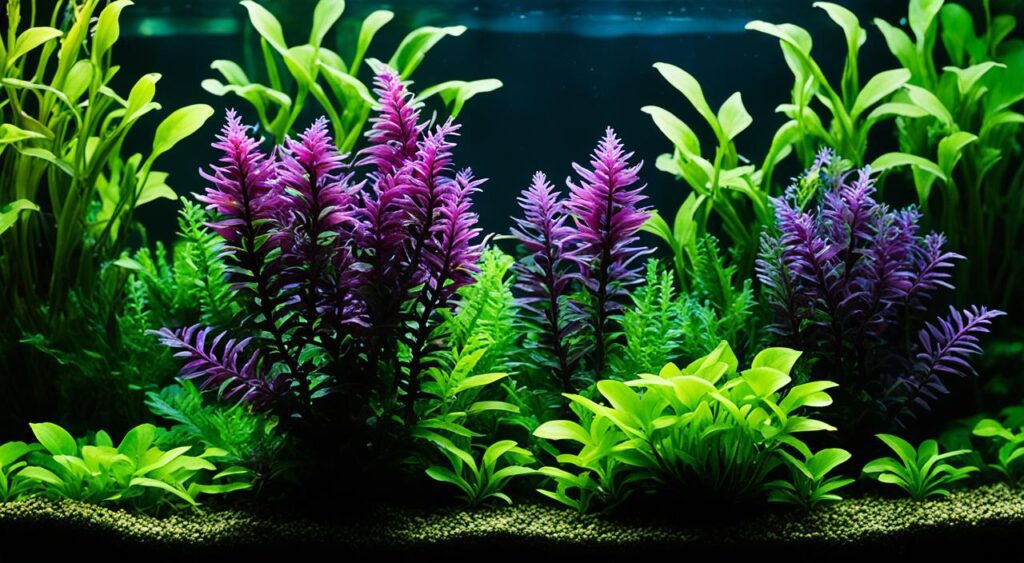
Bucephalandra is a versatile plant when it comes to placement in an aquarium. It can be used as a foreground or midground plant, or it can be attached to hardscape elements such as rocks or driftwood. The flexibility in placement allows for creative aquascape designs and the opportunity to showcase the unique foliage of bucephalandra.
One of the key characteristics of bucephalandra is that it thrives in low-light conditions. This makes it an excellent choice for aquarists who prefer low-light plants or aquariums with low to moderate lighting. Providing adequate lighting for photosynthesis is crucial for the plant’s health, but it’s essential to avoid high-intensity lighting as it can lead to algae growth.
When considering the placement of bucephalandra in an aquarium, it’s essential to consider its growth habit and the desired visual effect. Placing bucephalandra as a foreground plant can create a lush and vibrant carpet effect, and placing it as a midground plant can add depth and dimension to the aquascape.
Here are a few placement ideas for bucephalandra:
- Attach bucephalandra to rocks or driftwood to create natural-looking clusters or focal points in the aquarium.
- Create a bucephalandra carpet in the foreground by planting it close together and allowing it to spread and cover the substrate.
- Combine bucephalandra with other low-light plants to create a diverse and visually appealing aquascape.
- Use bucephalandra as a centrepiece or focal point by placing it in the middle of the aquarium and surrounding it with other plants or hardscape elements.
By considering the lighting requirements of bucephalandra and utilizing its placement flexibility, aquarists can create visually stunning and balanced aquascapes that showcase the beauty of this unique plant.
| Placement Tips | Lighting Requirements |
|---|---|
| Use bucephalandra as a foreground or midground plant | Low to moderate lighting levels |
| Attach bucephalandra to rocks or driftwood | Avoid high-intensity lighting to prevent algae growth |
| Create a bucephalandra carpet | Provide sufficient lighting for photosynthesis |
| Use bucephalandra as a centrepiece or focal point | |
| Use bucephalandra as a centrepiece or focal point. |
What Are Good Tank Mates?
Bucephalandra is a versatile aquarium plant that can coexist harmoniously with various tank mates. When selecting companions for your bucephalandra, it is crucial to consider their compatibility in terms of water parameters and behaviour. Opting for peaceful community fish, shrimp, and snails can help create a balanced and thriving aquatic ecosystem.
Good Tank Mates
Several species make excellent tank mates for bucephalandra. These include:
- Tetras
- Rasboras
- Dwarf gouramis
- Corydoras catfish
- Small plecos
These community fish are known for their peaceful nature and compatibility with various aquatic plants. They will not threaten the delicate leaves of bucephalandra and can happily coexist in the same tank.
Fish Species To Avoid
While many suitable tank mates exist for bucephalandra, avoiding aggressive or fin-nipping fish species that may cause damage is essential. Examples of fish species to avoid when keeping bucephalandra include:
- Aggressive cichlids
- Large, active fish that may uproot plants
By avoiding these species, you can create a peaceful and stress-free environment for your bucephalandra and ensure its long-term health and beauty.
Feeding (Fertilization)
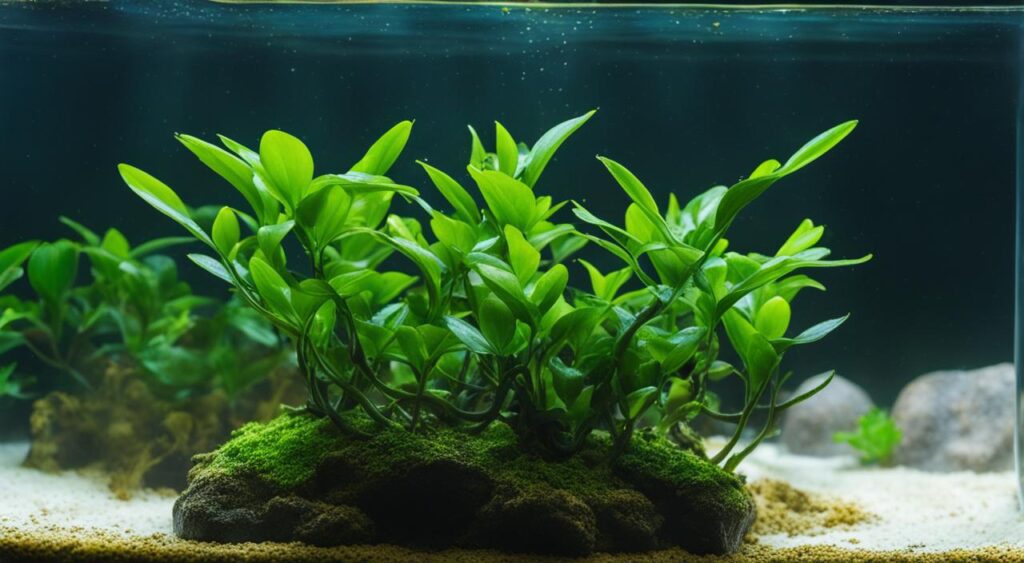
Bucephalandra plants require proper feeding and fertilization to maintain healthy growth. They obtain most of their nutrients from the water column through their leaves and roots.
It is recommended to provide regular fertilization with a balanced liquid fertilizer that contains essential macronutrients and micronutrients. Liquid fertilizers are especially beneficial for bucephalandra plants as they ensure efficient nutrient absorption and provide targeted nutrition.
The frequency and amount of fertilizer required may vary depending on the size of the aquarium, the number of plants, and the nutrient demands of the other aquatic species. Following the manufacturer’s instructions for the specific fertilizer product being used is essential.
When feeding bucephalandra, it is crucial to consider their nutrient requirements. These plants rely on macronutrients such as nitrogen (N), phosphorus (P), and potassium (K), as well as essential micronutrients, including iron (Fe), magnesium (Mg), and calcium (Ca).
CO2 Injection
Types
Bucephalandra plants can benefit from aquarium carbon dioxide (CO2) supplementation. CO2 injection provides a carbon source for the plants, promoting faster growth and lush foliage. Different CO2 injection methods are available, including pressurized CO2 systems and DIY yeast CO2 systems.
The optimal CO2 levels for bucephalandra plants are typically 20-30 parts per million (ppm). It is vital to monitor CO2 levels and adjust the injection rate accordingly to prevent CO2 overdosing, which can harm the aquatic ecosystem.
CO2 Injection Methods
| CO2 Injection Method | Description |
|---|---|
| Pressurized CO2 Systems | Utilizes a pressurized CO2 cylinder and a regulator to deliver controlled amounts of CO2 to the aquarium. |
| DIY Yeast CO2 Systems | Uses a mixture of sugar, water, and yeast to produce CO2 through fermentation. The CO2 is released into the aquarium through a diffuser or reactor. |
Care
Proper care is essential for the healthy growth and well-being of bucephalandra plants. In this section, I will provide the necessary information to ensure your bucephalandra thrives in your planted tank.
Planted Tank Parameters
Creating the right environment for your bucephalandra is crucial for its success. Here are the recommended parameters for a planted tank:
- Temperature: 72-82°F (22-28°C)
- pH: 6.0-7.5
- Hardness: Soft to moderately hard water (4-10 dKH)
- Lighting: Low to moderate intensity
- Substrate: A rich substrate with a mix of fine gravel or sand
- CO2: Optional but beneficial for faster growth (more on this in Section 8)
Maintaining these parameters will create an ideal environment for your bucephalandra to thrive.
Water Quality
Ensuring good water quality is essential for the health of your bucephalandra. Here are some key points to remember:
- Regularly test your water parameters to ensure they are within the recommended range.
- Keep ammonia, nitrite, and nitrate levels in check by performing regular water changes.
- Use a high-quality water conditioner to remove chlorine and chloramine from tap water.
- Avoid the use of copper-based medications or treatments, as they can be harmful to bucephalandra.
Maintaining good water quality will help prevent any issues and promote the overall health of your bucephalandra.
Filtration
Proper filtration is vital for your bucephalandra’s well-being and your aquarium’s overall health. Here are some considerations:
- Choose a filter that provides both mechanical and biological filtration.
- Aim for a filtration system that has a turnover rate of 5-10 times the tank volume per hour.
- Regularly clean and maintain your filter to prevent debris buildup and ensure optimal filtration.
A well-functioning filtration system will help maintain water clarity and remove any waste or toxins that could harm your plants.
Flow
Proper water flow is crucial for the health and growth of bucephalandra. Here’s what you need to know:
- Avoid stagnant areas in your aquarium by directing your filter outlet and using circulation pumps if necessary.
- Ensure even distribution of water flow throughout your tank to prevent dead spots.
- Monitor your bucephalandra for any signs of excessive flow, such as torn or damaged leaves, and adjust the flow accordingly.
Optimal water flow will help deliver nutrients to your bucephalandra and ensure oxygen exchange for the plants and other aquatic inhabitants.
Following these care tips and maintaining optimal conditions in your planted tank will provide the ideal environment for your bucephalandra to thrive and contribute to a vibrant aquascape.
Aquarium Maintenance
Testing Water Conditions
Regular testing of water conditions is essential for maintaining a healthy environment for your bucephalandra and other aquatic inhabitants. Monitoring key parameters such as pH, ammonia, nitrite, and nitrate levels will help you identify any potential imbalances or issues that may affect the well-being of your plants and fish. Use reliable water testing kits or meters to measure these parameters regularly and accurately.
How To Set Up Your Aquarium Tank
Properly setting up your aquarium tank is crucial for providing a suitable habitat for bucephalandra. Here are some critical steps to follow:
- Choose an appropriate tank size based on the number of plants and fish you plan to keep. Bucephalandra can be grown in both small and large tanks.
- Add a layer of nutrient-rich substrate to the bottom of the tank to promote healthy plant growth. Bucephalandra plants can benefit from substrates specifically designed for aquatic plants.
- Install a reliable filtration system to maintain water quality and prevent the buildup of harmful substances. A combination of mechanical, chemical, and biological filtration is recommended.
- Set up suitable lighting for your bucephalandra. Low to moderate levels of light are ideal to avoid excessive algae growth. LED lights with adjustable brightness are a popular choice for planted aquariums.
- Cycle your aquarium to establish a beneficial bacterial colony before adding bucephalandra and other aquatic inhabitants. This will help maintain stable water parameters and reduce the risk of fish and plant stress.
Propagation Methods
Bucephalandra can be propagated through various methods to expand your collection or share with fellow hobbyists. Here are a few common propagation methods:
- Division: Gently separate the offshoots or daughter plants from the mother plant and plant them individually in the substrate.
- Rhizome Cutting: Cut a portion of the rhizome with healthy roots and plant it on the substrate. Ensure each cutting has at least one growing point to promote new plant growth.
- Leaf Cutting: Carefully remove a healthy leaf from the mother plant and plant it in the substrate. Over time, new plants may emerge from the base of the leaf.
- Bareroot Planting: Trim the mother plant’s roots and replant them in the substrate. The trimmed roots will regrow, and new shoots may develop.
To maintain a well-groomed appearance and prevent overgrowth, consider regular trimming and pruning of bucephalandra. Remove any dead or decaying leaves and trim back excessive growth to promote healthier plants and enhance the visual appeal of your aquascape.
Health And Disease
Maintaining the health of bucephalandra plants is essential for their long-term survival in the aquarium. Ensuring their well-being requires a keen eye for signs of good health and an understanding of common health issues that may arise. In this section, I will discuss the signs of good health to look out for and signs of poor health that may indicate underlying issues that need attention. Furthermore, I will cover common health issues that bucephalandra may encounter and provide appropriate treatment methods. Additionally, I will address plant pests that can affect bucephalandra and suggest preventive measures and treatment options.
Signs Of Good Health
Recognizing signs of good health in your bucephalandra plants is crucial for ensuring their overall well-being. Here are some key indicators to look for:
- Vibrant foliage: Healthy bucephalandra plants exhibit rich, lush greenery with vibrant colours.
- New growth: New leaves and shoots indicate the plant is actively growing.
- Adherence to planted tank parameters: When bucephalandra plants thrive within the established water parameters, it is a positive sign of their health.
Signs Of Poor Health
Identifying signs of poor health in bucephalandra plants is essential for timely intervention and appropriate care. Here are some concerning signs to watch out for:
- Yellowing leaves: Yellow or discoloured leaves may indicate nutrient deficiencies or other health issues.
- Rotting roots: Soft, mushy, or decaying roots can signify root rot or poor water quality.
- Stunted growth: Lack of new or stunted development may suggest underlying health problems or unfavourable conditions.
Common Health Issues And Treatment
Bucephalandra plants can experience a variety of health issues that require prompt treatment. Here are some common health issues and their appropriate treatment methods:
| Health Issue | Treatment |
|---|---|
| Leaf melt | Trim affected leaves and provide optimal water parameters and nutrient balance. |
| Brown spots | Adjust lighting and nutrient levels, ensuring they are within the appropriate range. |
| Algae overgrowth | Modify lighting intensity, duration, and nutrient levels. Manual removal may also be necessary. |
| Mineral deficiencies | Supplement with appropriate fertilizers or adjust water parameters to address deficiencies. |
Plant Pests
Plant pests can pose a threat to the health of bucephalandra plants. Here are some common pests and strategies to prevent and treat infestations:
- Snails: Manual removal and controlling population through traps or snail-eating fish.
- Shrimps: Shrimps can help control algae and organic debris in the aquarium, benefiting bucephalandra plants.
- Aphids: Introduce natural predators or use organic insecticides to eliminate aphids.
- Spider mites: Regularly inspect plants for signs of insect infestation and treat with appropriate miticides.
Summary
In conclusion, bucephalandra is a captivating aquarium plant that adds a touch of uniqueness and beauty to any aquascape. Its attractive foliage and relatively low maintenance requirements make it a popular choice among aquarium hobbyists. Following the care tips outlined in this guide, you can cultivate and maintain a thriving bucephalandra-filled aquarium.
To ensure the healthy growth of bucephalandra, it is essential to provide appropriate lighting, water parameters, and regular fertilization. Bucephalandra thrives in low to moderate lighting conditions, so avoid high-intensity lighting that can promote algae growth. Maintaining stable water parameters and providing balanced fertilization will also support the plant’s nutrient needs.
A stunning aquascape featuring bucephalandra can be created with proper care and maintenance. Remember to consider placement, compatibility with tank mates, and the importance of regular aquarium maintenance to ensure the long-term health and vibrance of your bucephalandra plants. By incorporating these key takeaways into your aquascaping journey, you can enjoy the beauty and tranquillity of a bucephalandra-filled aquarium.
FAQ
What is bucephalandra?
Bucephalandra is a genus of aquatic plants known for its unique and attractive foliage. It is highly sought after by aquarium hobbyists for its beauty and relatively low maintenance requirements.
What species and varieties of bucephalandra are available?
Bucephalandra comes in various species and varieties, including Green Wavy, Kedagang, Red Mini, Blue Mini, Brownie Blue, Theia Green, and Black Pearl.
Where is bucephalandra native to?
Bucephalandra is native to the island of Borneo and is commonly found growing along the banks of fast-moving streams and rivers.
How should bucephalandra be placed in an aquarium?
Bucephalandra can be used as a foreground or midground plant, or it can be attached to hardscape elements such as rocks or driftwood to create visually appealing aquascapes.
What lighting requirements does bucephalandra have?
Bucephalandra is considered a low light plant and can thrive in aquariums with low to moderate lighting levels. It is important to provide sufficient lighting for photosynthesis, but high-intensity lighting should be avoided to prevent algae growth.
What are good tank mates for bucephalandra?
Good tank mates for bucephalandra include tetras, rasboras, dwarf gouramis, corydoras catfish, and small plecos. It is important to avoid aggressive or fin-nipping fish species that may damage the delicate leaves of bucephalandra.
How should bucephalandra be fertilized?
Bucephalandra obtains most of its nutrients through its leaves and roots from the water column. Regular fertilization with a balanced liquid fertilizer that contains essential macronutrients and micronutrients is recommended.
Does bucephalandra require CO2 supplementation?
Bucephalandra can benefit from carbon dioxide (CO2) supplementation in the aquarium. CO2 injection provides a source of carbon for the plants, promoting faster growth and lush foliage.
What are the care requirements for bucephalandra?
Proper care for bucephalandra includes maintaining optimal planted tank parameters, water quality, filtration, and appropriate flow in the aquarium. Regular aquarium maintenance, including testing water conditions and trimming/pruning, is also important.
How can bucephalandra be propagated?
Bucephalandra can be propagated through various methods, including division, rhizome cutting, and tissue culture. Each method has its own requirements and techniques.
What are the signs of good health for bucephalandra?
Signs of good health for bucephalandra include vibrant foliage, new growth, and adherence to planted tank parameters.
What are common health issues for bucephalandra and how can they be treated?
Common health issues for bucephalandra include yellowing leaves, rotting roots, and stunted growth. They may indicate underlying issues such as nutrient deficiencies or disease, which can be addressed through appropriate treatment methods.
Are there any plant pests that can affect bucephalandra?
Yes, bucephalandra can be susceptible to plant pests such as snails and algae. Preventive measures and treatment options should be employed to keep these pests under control.

